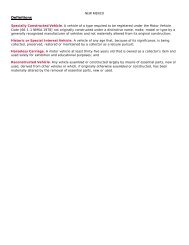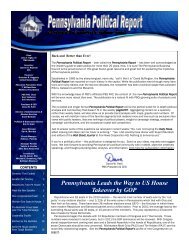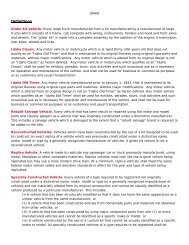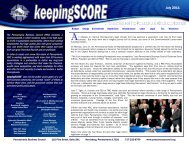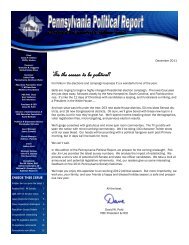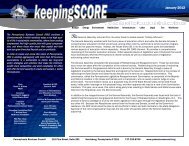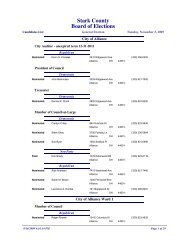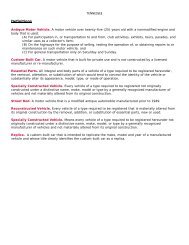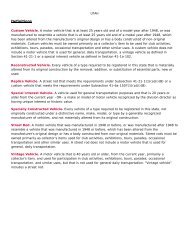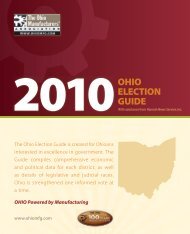LOUISIANA Definitions - BIPAC
LOUISIANA Definitions - BIPAC
LOUISIANA Definitions - BIPAC
Create successful ePaper yourself
Turn your PDF publications into a flip-book with our unique Google optimized e-Paper software.
c. Buses, regardless of the number of axles, not having a manufacturer's gross weight rating shall have a<br />
braking distance of 40 feet.<br />
d. All combinations of vehicles in drive away, tow-away operations shall have a braking distance of 40<br />
feet.<br />
e. All other combination vehicles shall have a braking distance of 50 feet.<br />
E. Brake Requirement<br />
1. Any vehicle registered as a farm trailer, farm semi-trailer, rubber-tired farm wagon, drawn rubber-tired<br />
farm equipment or implements of husbandry manufactured or assembled prior to January 1, 1973, and<br />
operated or moved only incidentally on the highways of this state, shall be exempt from brake<br />
requirements provided that:<br />
a. the gross weight does not exceed 10,000 pounds;<br />
b. the speed does not exceed 30 miles per hour;<br />
c. fertilizer distributors or spreaders are exempt from brake requirements. Commercially owned anhydrous<br />
ammonia nurse tank trailers used for the transportation and storage of fertilizer are exempt from the<br />
braking requirements.<br />
2. Every registered vehicle when presented for inspection shall be equipped with brakes in accordance<br />
with the requirements herein stated.<br />
a. Every motor vehicle, other than motorcycles or motor driven cycles, shall be equipped with brakes<br />
adequate to control movement of and to stop and hold movement of such vehicle. Two separate means of<br />
applying brakes are required, each of which shall effectively apply brakes to at least two wheels.<br />
b. Every motorcycle and every motor driven cycle shall be equipped with at least one brake which may be<br />
operated by hand or foot.<br />
c. Every motorcycle and every motor driven cycle manufactured with two wheels shall be required to be<br />
equipped with brakes on both wheels.<br />
d. Every 1963 or later model year motor vehicle shall be equipped with brakes on all wheels.<br />
e. Every trailer or semi-trailer exceeding 3,000 pounds gross weight shall be equipped with brakes acting<br />
on all wheels.<br />
3. The following exceptions exist.<br />
a. Trailers and semi-trailers having a gross weight between 3,000 pounds and 5,000 pounds need only be<br />
equipped with brakes on a single axle.<br />
b. Trailers and semi-trailers manufactured or assembled prior to January 1, 1963, need only be equipped<br />
with brakes on a single axle provided the combination of vehicles, consisting of the towing vehicle and its<br />
total load, is capable of complying with the performance requirements.<br />
c. Farm trailers and semi-trailers manufactured or assembled prior to January 1, 1973, need not be<br />
equipped with brakes. Every farm trailer and farm semi-trailer manufactured or assembled on or after<br />
January 1, 1973, and having a gross weight exceeding 3,000 pounds shall be equipped with brakes in<br />
accordance with the requirements set forth above.<br />
d. Log trailers shall be exempt from brake requirements until January 1, 1973, after which time they shall<br />
be equipped with brakes in accordance with the requirements set forth above.<br />
e. Trucks and truck-tractors, 1963 and older, which have had an additional axle and wheels (tag axle)<br />
added for the purpose of allowing a greater payload must be capable of complying with brake performance





